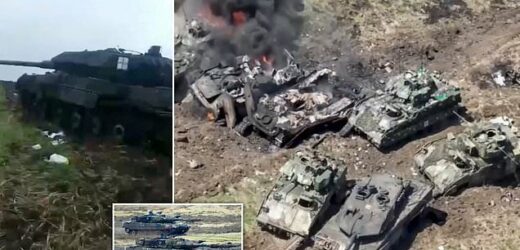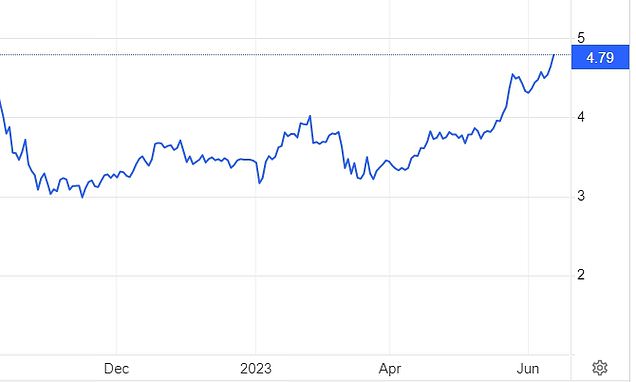Russia boasts it has captured German Leopard tanks and US Bradley vehicles – as Berlin admits it cannot replace the tanks they are donating to Ukraine
- Russia’s defence ministry released a short clip on its official Telegram channel
- It showed a group of Putin’s soldiers inspecting a series of captured vehicles
- Germany’s defence minister said the Leopard 2 tanks could not be replaced
Putin’s forces have captured several German-made Leopard 2 tanks and US-made Bradley infantry fighting vehicles on the frontlines in Ukraine, Russia’s defence ministry claimed today.
The ministry released a short clip on its official Telegram channel which appeared to show Russian troops surveying the seized equipment supplied to Ukraine by Western countries.
‘Leopard tanks and Bradley infantry fighting vehicles. These are our trophies. Equipment of the Ukrainian armed forces in the Zaporizhzhia region,’ the defence ministry said in a statement.
‘Servicemen of the Vostok group inspect enemy tanks and infantry fighting vehicles captured in battle.’
The vehicles had evidently been damaged amid frontline skirmishes, but the defence ministry said several of the captured vehicles had working engines, suggesting that this suggested the battles they were involved in had been short.
It comes as Germany’s defence minister admitted the country will not immediately be able to replace the tanks it has provided to Ukraine.
Russian soldiers inspect captured vehicles on the frontline, including Leopard 2 tanks
The vehicles had evidently been damaged amid frontline skirmishes, but the defence ministry said several of the captured vehicles had working engines
An image provided by the Russian Defence Ministry’s press service on 10 June 2023 shows German and American Bradley infantry fighting vehicles destroyed in combat in the Zaporizhzhia region, southern Ukraine
Two Leopard 2 tanks are seen in action during a visit of German Defense Minister Boris Pistorius at the Bundeswehr tank battalion 203 at the Field Marshal Rommel Barracks in Augustdorf, Germany, Feb. 1, 2023
A US Army M2 Bradley infantry fighting vehicle
Berlin earlier this year started sending advanced Leopard 2 battle tanks to Ukraine, after months of pleas from Kyiv for the heavy weapons to bolster its fightback against Russia.
READ MORE: Ukraine dam explosion is ‘Europe’s worst environmental disaster since Chernobyl’
Defence Minister Boris Pistorius told broadcaster RTL in an interview aired late Monday that ‘we will not be able to replace every tank that is now out of action’.
He refused to confirm the authenticity of images circulating online purportedly showing some of the tanks damaged in battle.
But he added that ‘unfortunately it is the nature of war that weapons are destroyed, that tanks are destroyed and people are killed.
‘That is why our support for Ukraine is so important.’
Other Ukrainian and German politicians have been calling for rapid resupply of tanks given the destruction of the armaments.
Pistorius said Berlin would continue to supply the less advanced Leopard 1 tanks, and there would be over 100 by the end of the year.
After coming under sustained pressure, Berlin in January agreed that the German-made tanks could be sent to Ukraine.
The government has so far delivered 18 of the advanced Leopard 2 tanks to Ukraine.
In an attempt to avoid a further depletion of military stocks as the war in Ukraine rumbles on, the heads of leading arms-making companies meet NATO defence ministers this week to discuss increasing production and standardising artillery shells.
NATO Secretary-General Jens Stoltenberg warned in February that Kyiv was burning through shells much faster than Western countries could produce them. The start of Ukrainian counteroffensive is certain to lead to even greater use.
But the lack of common standards among the various manufacturers has hampered the flow of munitions supplies.
‘It is about supercharging the NATO standardisation process in order to enable smoother supplies, which will help prevent delays and shortfalls in the future,’ a NATO official, speaking on condition of anonymity, told Reuters ahead of the meeting in Brussels on Thursday and Friday.
Those invited include BAE Systems, Turkish drone maker Baykar, General Dynamics, the KNDS holding representing Leopard 2 producer KMW and French Nexter, Kongsberg, Leonardo, Lockheed, MBDA and Northrop Grumman, according to a defence source.
NATO has been talking with industry representatives about boosting defence production since last year, but this is the first time the alliance holds such a high-level gathering.
Discussions on Thursday will focus on ways how to ramp up supplies of artillery shells, air defences and precision guided deep-strike ammunitions, missiles with a range of hundreds of kilometres such as the British Storm Shadow.
Gun barrels for Leopard battle tanks are pictured at the facility of German armaments company and automotive supplier Rheinmetall in Unterluess, northern Germany, on June 6, 2023
Ukrainian artillery fires towards the frontline during heavy fighting amid Russia’s attack on Ukraine, near Bakhmut, Ukraine, April 13, 2023
A technician of German armaments company and automotive supplier Rheinmetall works on 155mm ammunition that will be delivered to Ukrainian Forces for the Panzerhaubitze 2000 (armoured howitzer 2000)
A Storm Shadow Cruise missile in display inside the R.A.F. Museum
Production of artillery ammunition, for example for the Panzerhaubitze 2000, in a production hall of the armaments group Rheinmetall AG for further processing on June 06, 2023 in Unterluess, Germany
A Ukrainian soldier fires a mortar at Russian positions on the frontline near Bakhmut, Donetsk region, Ukraine, Sunday, May 28, 2023
Demand for 155mm artillery rounds has soared in the wake of the invasion of Ukraine in February 2022. But allies’ supplies for their own defence have been run down as they have rushed shells to Kyiv, which fires thousands of rounds per day.
While NATO enforces standards for rounds fired by small arms such as assault rifles, enabling troops from all allies to use each others’ munitions, it is not so easy for artillery shells.
Although some large NATO countries have agreed on certain standards for the 155mm rounds used by howitzers, additional calculations are often needed to hit a target with the required precision, experts say.
The NATO official said companies themselves have an interest in producing rounds that can be fired by multiple countries, with orders worth billions of euros expected as the war drags on in Ukraine.
A defence industry source welcomed NATO’s push for more standardisation and called it ‘long overdue’.
‘If national governments could bring themselves to throw national standards overboard and agree on common NATO standards – in particular with regard to munitions – this would be a landslide change,’ the defence source said.
Standardisation would also be useful for 120mm tank rounds.
‘This would be a real gamechanger. You could go looking for 120mm shells all over the world – because the ones that suit the (German) Leopard (tank) will work as well with the (US) Abrams.’
Still, NATO may run into opposition from ammunition makers as such a move could raise competition and lower prices.
‘There are hard-hitting business interests behind the entire ammunitions issue,’ the industry source said.
‘Companies are making money out of the fact that ammunitions are not interchangeable, that they can dominate their national markets with their munitions.’
The push for more standardisation comes at a crucial time when defence companies can already see much bigger orders on the horizon as NATO, at its Vilnius summit in July, is about to raise targets for how much munitions allies have to stockpile.
More than a year of conflict in Ukraine has left national inventories badly depleted. Before that many NATO countries had run down their stocks as governments considered wars of attrition with big artillery battles a thing of the past.
‘It will take six to 10 years until all European munitions depots will be filled up again,’ Rheinmetall CEO Armin Papperger told the German RND newspaper group in an interview.
Rheinmetall is one of the biggest producers of artillery munitions and is about to ramp up its production capacity to 600,000 from 450,000 rounds of 155mm shells per year.
Source: Read Full Article
















